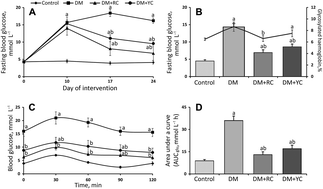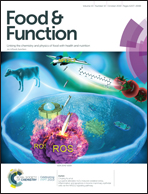Antidiabetic effects of extracts of red and yellow fruits of cornelian cherries (Cornus mas L.) on rats with streptozotocin-induced diabetes mellitus
Abstract
The effects of extracts of red and yellow fruits of cornelian cherries have been evaluated in rats with streptozotocin-induced diabetes mellitus. Cornus mas L. active compounds were analyzed by ultra-performance liquid chromatography coupled with electrospray ionization mass spectrometry (UPLC-ESI-qTOF-MS/MS) in positive and negative ion modes and by HPLC-PDA, followed by the identification of iridoids, anthocyanins, phenolic acids and flavonols. Rats with type 1 diabetes mellitus were orally dosed with the extracts in amounts of 20 mg kg−1 of body weight for 14 days. The cornelian cherry extracts lowered blood glucose and improved glucose tolerance. The treatments significantly decreased the amount of glycated hemoglobin (by 25%) and increased erythrocyte resistance to acid hemolysis. Importantly, only treatment with the extract of yellow fruits of the cornelian cherry increased the level of reduced glutathione and mean cell hemoglobin in diabetic rats. The active compounds of Cornus mas L. demonstrated the antidiabetic and antioxidant effects via the attenuation of hyperglycemia and inhibition of oxidative modifications of proteins and lipids, advanced glycation and oxidation protein formation or accumulation. The results suppose that cornelian cherries can be considered as a food supplement to alleviate diabetes mellitus and its complications.



 Please wait while we load your content...
Please wait while we load your content...